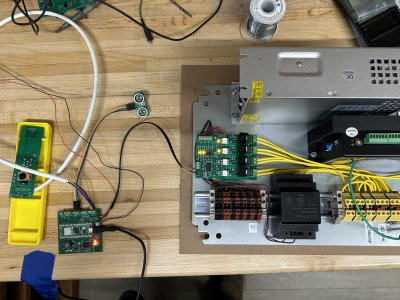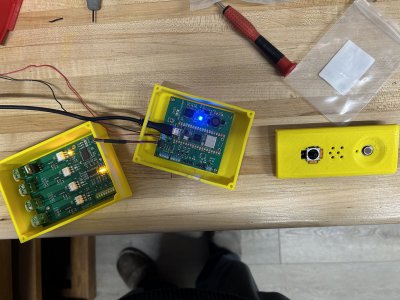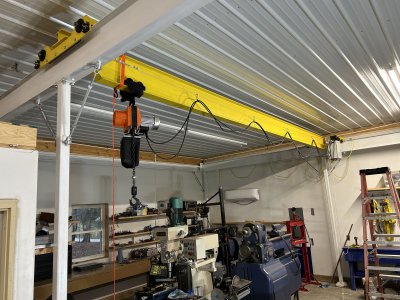-
Welcome back Guest! Did you know you can mentor other members here at H-M? If not, please check out our Relaunch of Hobby Machinist Mentoring Program!
You are using an out of date browser. It may not display this or other websites correctly.
You should upgrade or use an alternative browser.
You should upgrade or use an alternative browser.
Bridge Crane build
- Thread starter rabler
- Start date
- Joined
- Dec 20, 2021
- Messages
- 868
Looks great! Looking at cad of parts isn't the same as looking at the real thing, it's great to see it coming together!Crane is basically assembled.
- Joined
- Feb 25, 2021
- Messages
- 3,129
Absolutely. That is part of the "and such", but does deserved to be explicitly listed. I doubt I'll document that here though, not interested in playing cameraman while doing that.Are you going to load test it?
- Joined
- Feb 25, 2021
- Messages
- 3,129
And it is nice to not have that long yellow beam at chest height down the middle of the shop.Looks great! Looking at cad of parts isn't the same as looking at the real thing, it's great to see it coming together!
- Joined
- Feb 25, 2021
- Messages
- 3,129
Still working on the crane, along with several other unrelated projects.
I said I was done with the design/fab stage, but nope. Decided I wanted a motorized bridge. Trolley will still be unpowered but the bridge is heavy enough that pushing/pulling it from the (yet to be installed) hoist cable is too strenuous for my tastes. So I decided to put together a controller, because I like building things.

On the right is the panel that goes in the electrical cabinet which will be mounted on one bridge truck in conjunction with the drive motor (a hi torque stepper and a 20:1 worm gear). The drive will be connected to one roller on each bridge truck via a 1.5" shaft on bearings along one side of the bridge.
The panel includes a DC power supply (large silver box on the top). It is rated for 60 VDC at 25 amps. But like typical chinese stuff, it has a sticker on it, and the documentation says, "load not to exceed 80% of rating." That makes it a 20 amp power supply in my book! I need 16 amps so good enough. The block box below and right of the power supply is a the chopper drive for the stepper. The lower black box is a 12VDC power supply for the controllers. Circuit board on the left of the panel is a switch module, 4 channels of switching for 12VDC, and 4 channels for 120 VAC, controlled via I2C with complete optical isolation between the I2C input and the switched circuits. One of the 12VDC channels will control a cooling fan for the box, another to control an external power-on indicator. One of the 120VAC channels will switch on the 60VDC stepper power supply, so that the MCU can power down the stepper on an idle time-out. Two other 120VAC channels will act as (future) switches for a motorized hoist on the trolley.
The board with the 2 LEDs turned on is the central controller. It mounts in a 3D printed plastic blister on the bottom of the cabinet for the above panel. Wanted it outside the metal cabinet since I hope to eventually use the onboard bluetooth that comes with the MCU (Pico W). For now it will connect to a pendant via a UART/EIA-232. I'm using a voltage converter and real RS-232 drivers for improved noise immunity. The little 'dongle' with the two discs (bug eyes?) is an ultrasonic sonar sensor. The controller will have two of those, just one connected on the bench. Those sensors will help (along with limit switches) to determine when the bridge is nearing the wall (end of travel) and slow down to a stop. They get mounted in the same printed plastic blister as the controller.
The yellow plastic on the left is the pendant controller. A few LEDs, a switch, and a X/Y joystick, and the matching UART circuitry connected to an MCU. The yellow plastic thingy is the first prototype bottom half of the pendant remote controller with space for 3 AAA batteries in addition to the PCB. Batteries needed for complete wireless (bluetooth) operation, it is powered over the cable if I'm using it in RS-232 wired pendant mode.
For safety, the central controller will stop everything if it doesn't get an update from the remote in more than 50 milliseconds. And an E-stop botton on the remote will force the centrol controler into a all-stop state, with a system reset required to reactivate.
Getting close to wrapping the electronics part of this up, but still a bit more wiring and coding needed. Then need to fabricate the mount for the electrical cabinet and drive motor so the whole thing attaches to the bridge. The crane columns were grouted nearly a month ago and should be at a reasonable percentage of max strength, so I can load test the crane at some point soon too.
I said I was done with the design/fab stage, but nope. Decided I wanted a motorized bridge. Trolley will still be unpowered but the bridge is heavy enough that pushing/pulling it from the (yet to be installed) hoist cable is too strenuous for my tastes. So I decided to put together a controller, because I like building things.

On the right is the panel that goes in the electrical cabinet which will be mounted on one bridge truck in conjunction with the drive motor (a hi torque stepper and a 20:1 worm gear). The drive will be connected to one roller on each bridge truck via a 1.5" shaft on bearings along one side of the bridge.
The panel includes a DC power supply (large silver box on the top). It is rated for 60 VDC at 25 amps. But like typical chinese stuff, it has a sticker on it, and the documentation says, "load not to exceed 80% of rating." That makes it a 20 amp power supply in my book! I need 16 amps so good enough. The block box below and right of the power supply is a the chopper drive for the stepper. The lower black box is a 12VDC power supply for the controllers. Circuit board on the left of the panel is a switch module, 4 channels of switching for 12VDC, and 4 channels for 120 VAC, controlled via I2C with complete optical isolation between the I2C input and the switched circuits. One of the 12VDC channels will control a cooling fan for the box, another to control an external power-on indicator. One of the 120VAC channels will switch on the 60VDC stepper power supply, so that the MCU can power down the stepper on an idle time-out. Two other 120VAC channels will act as (future) switches for a motorized hoist on the trolley.
The board with the 2 LEDs turned on is the central controller. It mounts in a 3D printed plastic blister on the bottom of the cabinet for the above panel. Wanted it outside the metal cabinet since I hope to eventually use the onboard bluetooth that comes with the MCU (Pico W). For now it will connect to a pendant via a UART/EIA-232. I'm using a voltage converter and real RS-232 drivers for improved noise immunity. The little 'dongle' with the two discs (bug eyes?) is an ultrasonic sonar sensor. The controller will have two of those, just one connected on the bench. Those sensors will help (along with limit switches) to determine when the bridge is nearing the wall (end of travel) and slow down to a stop. They get mounted in the same printed plastic blister as the controller.
The yellow plastic on the left is the pendant controller. A few LEDs, a switch, and a X/Y joystick, and the matching UART circuitry connected to an MCU. The yellow plastic thingy is the first prototype bottom half of the pendant remote controller with space for 3 AAA batteries in addition to the PCB. Batteries needed for complete wireless (bluetooth) operation, it is powered over the cable if I'm using it in RS-232 wired pendant mode.
For safety, the central controller will stop everything if it doesn't get an update from the remote in more than 50 milliseconds. And an E-stop botton on the remote will force the centrol controler into a all-stop state, with a system reset required to reactivate.
Getting close to wrapping the electronics part of this up, but still a bit more wiring and coding needed. Then need to fabricate the mount for the electrical cabinet and drive motor so the whole thing attaches to the bridge. The crane columns were grouted nearly a month ago and should be at a reasonable percentage of max strength, so I can load test the crane at some point soon too.
Last edited:
- Joined
- Feb 25, 2021
- Messages
- 3,129
With having to do all the barn chores as well as groceries and anything else outside the house, this has really slowed down. I moved the actual crane control panel out of the electrical/office area in preparation for making the brackets to mount the box, motor, and reduction gear. I went ahead and soldered up another set of boards to use for programming. I'm using this to work on the wireless control capability. The remote (on the right) has both bluetooth and wifi capability to the central controller (middle). IR would be another option but that would have required adding IR sensors, and IR is typically one way. The small holes on the remote will get acrylic rods bring out LED indicators showing for example that the sonar sensors are indicating the crane is near the end of travel.
Have obviously made use of the 3D printer to make the yellow plastic boxes. While useful, the 3D printers do seem finicky. I'm sure that using wood heat and having somewhat erratic temperatures doesn't help. I've started using the heated chamber on low (20 C) even with PLA to normalize that a bit.

Have obviously made use of the 3D printer to make the yellow plastic boxes. While useful, the 3D printers do seem finicky. I'm sure that using wood heat and having somewhat erratic temperatures doesn't help. I've started using the heated chamber on low (20 C) even with PLA to normalize that a bit.

- Joined
- Feb 25, 2021
- Messages
- 3,129
Progress is starting to pick up as my wife gets more mobile. I may yet get this done before the one year anniversary of starting this thread.

Still need to do a little work on the cables. The motor controller on the far end works well, single control to run the hoist and bridge motor. Traversing the length of the bridge will remain manually driven, no power feed there Need to fab and install a drive shaft across from the motor/worm drive to the remote end of the bridge. The hoist is only rated to 2200 lbs on a 2000 lb rated trolley, so will probably end up with a separate trolley and manual chain fall for the higher half of the intended load rating.
Need to fab and install a drive shaft across from the motor/worm drive to the remote end of the bridge. The hoist is only rated to 2200 lbs on a 2000 lb rated trolley, so will probably end up with a separate trolley and manual chain fall for the higher half of the intended load rating.

Still need to do a little work on the cables. The motor controller on the far end works well, single control to run the hoist and bridge motor. Traversing the length of the bridge will remain manually driven, no power feed there

